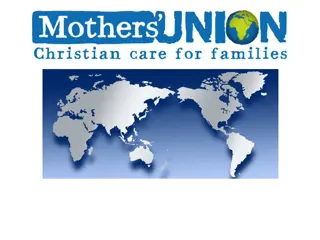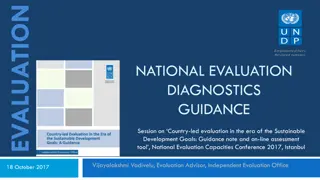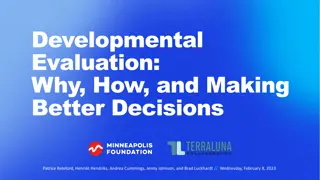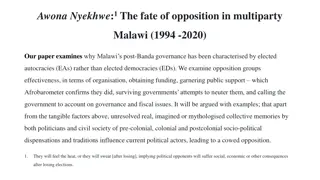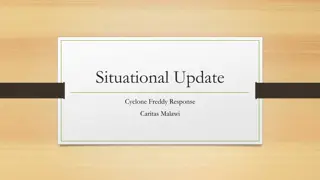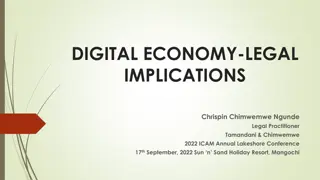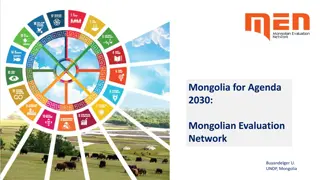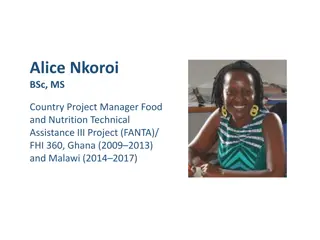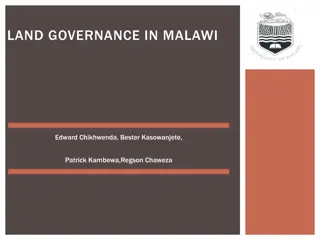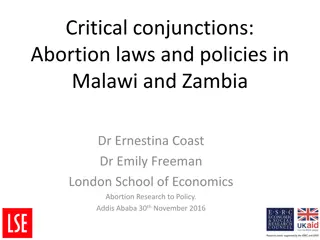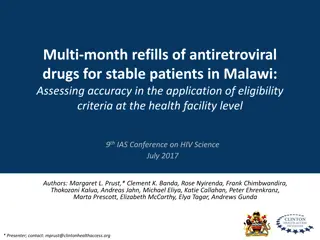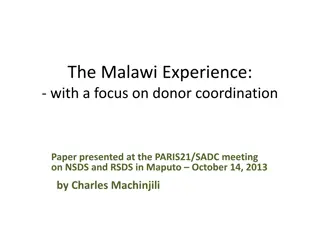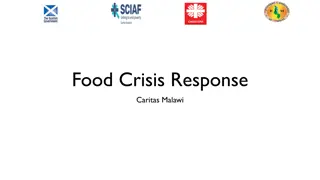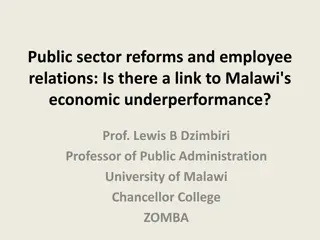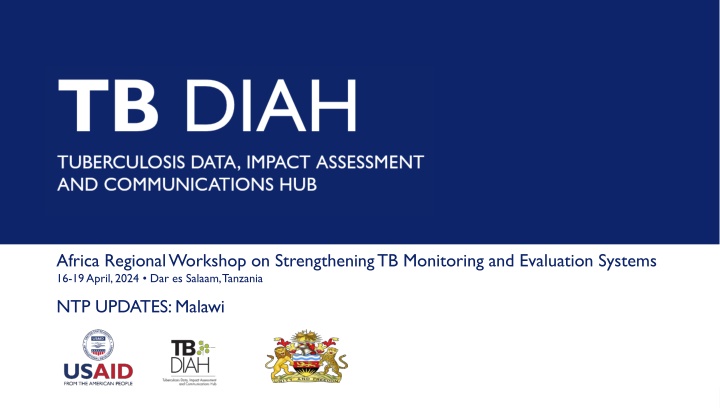
Strengthening TB Monitoring and Evaluation Systems in Malawi
Regional workshop in Dar es Salaam, Tanzania focusing on TB data, impact assessment, and communications in Malawi. Details on the National TB/Leprosy Strategic Plan, progress towards TB targets, and data-driven strategies for TB monitoring and evaluation are highlighted.
Download Presentation

Please find below an Image/Link to download the presentation.
The content on the website is provided AS IS for your information and personal use only. It may not be sold, licensed, or shared on other websites without obtaining consent from the author. If you encounter any issues during the download, it is possible that the publisher has removed the file from their server.
You are allowed to download the files provided on this website for personal or commercial use, subject to the condition that they are used lawfully. All files are the property of their respective owners.
The content on the website is provided AS IS for your information and personal use only. It may not be sold, licensed, or shared on other websites without obtaining consent from the author.
E N D
Presentation Transcript
Africa Regional Workshop on Strengthening TB Monitoring and Evaluation Systems 16-19 April, 2024 Dar es Salaam, Tanzania NTP UPDATES: Malawi Tuberculosis Data, Impact Assessment and Communications Hub (TB DIAH)
Country TB Profile and TB Situation Snapshot 2 Tuberculosis Data, Impact Assessment and Communications Hub (TB DIAH)
Overview of the National TB/Leprosy Strategic Plan (NSP) Vision: A TB and Leprosy free Malawi Pillars of the NSP: Mission: Ensure effective, equitable and accessible TB and Leprosy prevention, diagnosis, treatment and care services in Malawi 1. Patient-centered care and prevention Goals: Reduce TB incidence by 50% and mortality by 75% from 2015 to end of 2025. 2. TB co-morbidities and key populations Reduce TB incidence to 97/100,000 3. Bold policies and supportive systems Reduce TB related mortality of all TB patients to 18/100,000 4. Program management, M&E, research & innovation Zero catastrophic costs due to TB among affected families (i.e. less than 20% of annual household income) Eliminate Leprosy in all districts by 2025 (less than 1 case per 10,000 pop.) 3 Tuberculosis Data, Impact Assessment and Communications Hub (TB DIAH)
Progress Towards End-TB targets 2022- 2015 % of change Milestone by 2025 2015 2022 Incidence TB per 100,000 197 125 -72 -37% 50% Incidence TB/HIV per 100,000 105 61 -44 -42% Mortality hiv negative # mortality HIV pos # 3700 7800 -1800 -4200 -49% -54% 75% 75% 1900 3600 Incidence rate declined by 37 % --- anticipated to reach 50% by 2025 Overall mortality declined by 49(hiv negative ) & 54%(HIV positive ) individuals With the current rate of decline - Malawi is projected to meet the 2025 milestones. 4 Tuberculosis Data, Impact Assessment and Communications Hub (TB DIAH)
This slide contains the following visuals: Trend in TB incidence with case notification rate ,Estimated TB mortality rate by patient group ,Incidence of TB TB /HIV malawi ,columnChart. Please refer to the notes on this slide for details Tuberculosis Data, Impact Assessment and Communications Hub (TB DIAH)
Data-Driven Strategies: Update on national TB M&E, surveillance, and data use 6 Tuberculosis Data, Impact Assessment and Communications Hub (TB DIAH)
M&E Systems Standardized guideline and tools National guidelines: Adopts international indicator definition for TB M&E plan costed with indicator reference sheet Use standard SOPs Training packages Data management Mainly paper based DHIS 2 : all modules SMS technology : Gx alert E health cascade presumptive TB ---to diagnosis in 55 facilities EMR- implemented in 30 high volume health factifies Scan form : to be introduced in selected TB registers 7 Tuberculosis Data, Impact Assessment and Communications Hub (TB DIAH)
M&E Systems TB/HV supervision SOP for supervision SOP data management Data analysis syntax Data quality assessment Outputs Quarterly program update Annual program update annual reports PUDR / reporting to PEPFAR Balanced score card at district level 8 Tuberculosis Data, Impact Assessment and Communications Hub (TB DIAH)
Data Collection System Mobile diagnostic unit TB/HIV integrated Supportive Supervision Central referral laboratory ( external quality assurance ) Central referral laboratories ( DST activities Routine TB reporting system Outreach activities to using MDU to reach key Population NTP TB.HIV team national level Zonal lab supervisors District TB officers Health facilities District lab officers TB registration site 9 Tuberculosis Data, Impact Assessment and Communications Hub (TB DIAH)
Data Use Implementation of SOC (Standard of care implementation) Facility level standard of care logbook Indicators/targets monitored Action plan developed & follow up Balanced scorecard Key indicators covering different thematic areas (Case detection , diagnosis , TPT, Treatment outcome & DR TB ) Target set and categorization --- National & zonal review meetings Annual operational and strategic planning 10 Tuberculosis Data, Impact Assessment and Communications Hub (TB DIAH)
SCORE CARD @UNIONCONFERENCE #UNIONCONF worldlunghealth.org Tuberculosis Data, Impact Assessment and Communications Hub (TB DIAH)
Key M&E Related Activities Challenges Referral interfacility Lab test duplicates /repeat test Documentation in presumptive register Tracking contribution from different key population Presumptive TB cases who can't produce sputum Patient categorization diagnosed through LF-LAM Limitation with subnational TB burden estimate Regular data quality review TB /HIV supervision Training to TB officers. Review meetings Presupervision workshops TB officers at all districts Collaborative TB/HIV activities Data use for decision making: Prioritization matrix Tuberculosis Data, Impact Assessment and Communications Hub (TB DIAH)
TB M&E Beyond Numbers: Understanding trends in PBMEF core indicators 13 Tuberculosis Data, Impact Assessment and Communications Hub (TB DIAH)
This slide contains the following visuals: TB notification vs target ,lineChart ,lineChart. Please refer to the notes on this slide for details DST coverage: expected to improve with expansion of Xpert sites (10 color ) 7.1% A total 19.1k patients notified Of which 18823 were new and relapse TB cases Increase by 4.4% Attributed to sputum production ,index of suspicion Tuberculosis Data, Impact Assessment and Communications Hub (TB DIAH)
This slide contains the following visuals: Treatment outcome DR TB patients ,Treatment outcome for DS TB patients ,Treatment outcome HIV /TB patients . Please refer to the notes on this slide for details Percent Bacteriologically Confirmed 80 70 % bact confirmed 70 68 64 62 62 60 60 60 58 52 40 20 0 2014 2015 2016 2017 2018 2019 2020 2021 2022 2023 Year Tuberculosis Data, Impact Assessment and Communications Hub (TB DIAH)
3/11/2025 Key programmatic achievements and challenges Achievement Increased TB case finding -4.4% increase Sustained TSR for DS-TB at 90% Continued Implementation of FAST approaches (>100 facilities using different models) Started implementation of XDR testing in 3 sites Distributed 10 color machines to sites. Sustain performance HIV ascertainment and ART uptake Completed the pilot study for stool SOS Finalized the TB and Leprosy Guideline Challenges Low case finding for childhood TB Low Xpert among PLHIV Widening testing gap among presumptive TB patients Maintenance of EMR- Sites and limited coverage 16 Tuberculosis Data, Impact Assessment and Communications Hub (TB DIAH)
Action Points Narrowing gap in case finding for TB & Leprosy Continue FAST /active case finding interventions(X-ray) Implement childhood TB algorithm & SOS Strengthen and maintain quality TB diagnostic network Strengthen quality of community TB services Expansion of Drug sensitivity testing for TB & DR TB patients Strengthen quality of TB/HIV,DR TB & Leprosy services TB-HIV services PSM, quality of treatment ,Quality improvement initiative & Post TB care Maintain and expand e-health ( EMR ,ASPECT & DHIS 2) Strengthen quality of TB surveillance and data use 17 Tuberculosis Data, Impact Assessment and Communications Hub (TB DIAH)
This presentation was produced with the support of the United States Agency for International Development (USAID) under the terms of the TB Data, Impact Assessment and Communications Hub (TB DIAH) Associate Award No. 7200AA18LA00007. TB DIAH is implemented by the University of North Carolina at Chapel Hill, in partnership with John Snow, Inc. Views expressed are not necessarily those of USAID or the United States government. Tuberculosis Data, Impact Assessment and Communications Hub (TB DIAH)

